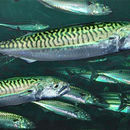Diagnostic Description
provided by FAO species catalogs
Palatine wide, teeth in two widely spaced rows. Space between first dorsal fin groove and second dorsal fin clearly greater (approximately 1.5 times) than length of groove; anal fin origin opposite that of second dorsal fin or nearly so; anal fin spine conspicuous, joined to the fin by a membrane but clearly independent of it. Swimbladder absent. Vertebrae 13 precaudal plus 18 caudal; first haemal spine anterior to first interneural process; 21 to 28 interneural bones under first dorsal fin. Colour: markings on back oblique to near vertical, with relatively little undulating; belly unmarked.
- Fischer, ed. (1973, Species Identification Sheets, Mediterranean and Black Sea)
- Collette, (1981, Species Identification Sheets, Eastern Central Atlantic)
- Sette, (1943, 1950)
- bibliographic citation
- FAO Species Catalogue. Vol. 2. Scombrids of the world. An annotated and illustrated catalogue of Tunas, Mackerels, Bonitos and related species known to date.Collette, B.B. & C.E. Nauen 1983.. FAO Fish. Synop., (125)Vol.2:137 p.
- author
- Food and Agriculture Organization of the UN
Distribution
provided by FAO species catalogs
North Atlantic Ocean, including the Baltic Sea; eastern Atlantic including the Mediterranean and the Black seas; and western Atlantic from Labrador to Cape Lookout
- bibliographic citation
- FAO Species Catalogue. Vol. 2. Scombrids of the world. An annotated and illustrated catalogue of Tunas, Mackerels, Bonitos and related species known to date.Collette, B.B. & C.E. Nauen 1983.. FAO Fish. Synop., (125)Vol.2:137 p.
- author
- Food and Agriculture Organization of the UN
Size
provided by FAO species catalogs
Maximum fork length is 50 cm, common to 30 cm. In the population off the US coast, length at first maturity is approximately 34 cm in females and 32 cm in males; in the eastern part of the geographical distribution, maturity may be attained at approximately 30 cm. Females grow bigger than males.
- bibliographic citation
- FAO Species Catalogue. Vol. 2. Scombrids of the world. An annotated and illustrated catalogue of Tunas, Mackerels, Bonitos and related species known to date.Collette, B.B. & C.E. Nauen 1983.. FAO Fish. Synop., (125)Vol.2:137 p.
- author
- Food and Agriculture Organization of the UN
Brief Summary
provided by FAO species catalogs
An epipelagic and mesodemersal species,most abundant in cold and temperate, shelf areas. Atlantic mackerel school by size.They overwinter in deeper waters but move closer to shore in spring when water temperatures range between 11° and 14° C. Two separate populations with little or no interchange seem to exist in the northwestern and northeastern Atlantic (including the Mediterranean). In the western population spawning takes place from Cheasapeake Bay to Newfoundland, initiating in the south in spring and progressively extending northward during the summer. Most of the spawing take place within 10 to 30 miles from shore, but never in low-salinity estuaries. Large fish are the first to arrive at the spawning sites. The eastern population spawns from March to April in the Mediterranean, from May to June off southern England, northern France and in the North Sea, and from June to July in the Kattegat and Skagerrak. Fecundity, in a medium-sized female, fluctuates between 200 000 and 450 000 eggs per season and increases with size; spawning occurs in batches. Maturity is attained at an age of 2 or 3 years. Juvenile Atlantic mackerel feed on zooplankton (fish larvae, small crustaceans, pteropods).As they grow, they are in turn preyed upon by tunas, sharks and dolphins.
- bibliographic citation
- FAO Species Catalogue. Vol. 2. Scombrids of the world. An annotated and illustrated catalogue of Tunas, Mackerels, Bonitos and related species known to date.Collette, B.B. & C.E. Nauen 1983.. FAO Fish. Synop., (125)Vol.2:137 p.
- author
- Food and Agriculture Organization of the UN
Benefits
provided by FAO species catalogs
There, are important fisheries for S. scombrus in Fishing Area 21 (Northwest Atlantic), Area 27 (Northeast Atlantic), and Area 37 (Mediterranean and Black Sea) The world catch declined from about 1.1 million t in 1975 to about 610 000 t in 1981 (FAO, 1983). Atlantic mackerel is mainly caught with purse seines, sometimes together with sardines. Surface catches are best when the summer thermocline is not deeper than 15 to 20 meters so as to prevent the mackerel from escaping into deeper water. Other types of gear in use include trolling lines, gillnets, traps, beach seines, and midwater trawls. The total catch reported for this species to FAO for 1999 was 610 947 t. The countries with the largest catches were UK (166 658 t) and Norway (160 816 t). This species is traded fresh, frozen, smoked and canned.
- bibliographic citation
- FAO Species Catalogue. Vol. 2. Scombrids of the world. An annotated and illustrated catalogue of Tunas, Mackerels, Bonitos and related species known to date.Collette, B.B. & C.E. Nauen 1983.. FAO Fish. Synop., (125)Vol.2:137 p.
- author
- Food and Agriculture Organization of the UN

